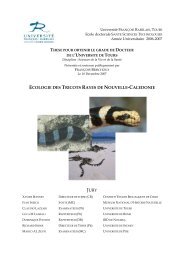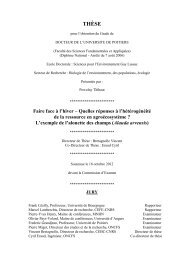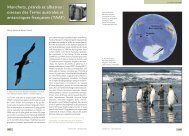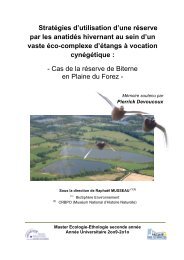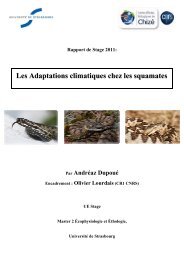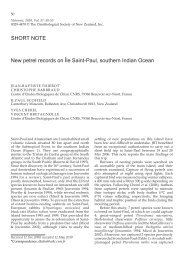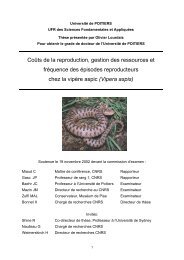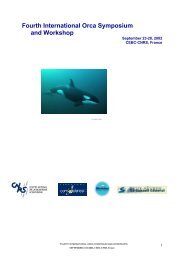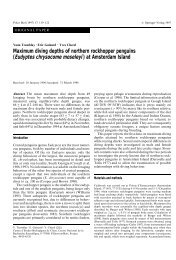Forçage environnemental et prédateurs marins ... - Cebc - CNRS
Forçage environnemental et prédateurs marins ... - Cebc - CNRS
Forçage environnemental et prédateurs marins ... - Cebc - CNRS
Create successful ePaper yourself
Turn your PDF publications into a flip-book with our unique Google optimized e-Paper software.
1466 C. Barbraud <strong>et</strong> al.<br />
Breeding success increased during the study period, but<br />
this increase may only concern the study colony where a rat<br />
control programme has been conducted since the late 1980s<br />
(Jouventin, Bried & Micol 2003). Breeding success is still<br />
probably low elsewhere where no rat control has been undertaken.<br />
Residual variations of breeding success around the<br />
increasing trend were due to fluctuations in fishery activities,<br />
which positively affected breeding success. This is in<br />
accordance with studies on the foraging ecology of breeding<br />
white-chinned p<strong>et</strong>rels at Possession Island. In 1997, remains<br />
of Patagonian toothfish were recorded in 40% of stomach<br />
samples collected after foraging trips, and preys associated<br />
with fisheries (bait, toothfish) were present in 70% of the chick’s<br />
food samples (Catard <strong>et</strong> al. 2000). No fishery waste was found<br />
b<strong>et</strong>ween 1981 and 1983 within the same population (Ridoux<br />
1994) when no longline fishery was active. Positive relationships<br />
b<strong>et</strong>ween breeding success and fishery activities are<br />
known from other seabird species (e.g. Oro 1999; Tuck <strong>et</strong> al.<br />
2001). This may indicate that some species directly benefit<br />
from offal resulting from increased fishing activities, although<br />
a purely correlative pattern cannot be excluded. Nevertheless,<br />
given the small contribution of breeding success to λ, the<br />
effect of fisheries through breeding success is small, and<br />
might even be negative on a long-term scale if fish stocks are<br />
overexploited and the structure of food webs is affected.<br />
Although our results suggest an effect of climate on the<br />
dynamics of this p<strong>et</strong>rel population, there was still some uncertainty<br />
for an effect of fisheries originating from the fact that<br />
immature survival could not be estimated from CMR data<br />
and the effect of fishing effort on this param<strong>et</strong>er could not be<br />
directly tested. Further evidence for a negative effect of mortality<br />
in fisheries on the population dynamics comes from the<br />
demographic invariant m<strong>et</strong>hod. Numbers killed by just the<br />
toothfish fishery exceeded the potential excess growth during<br />
several years, indicating that this fishery negatively impacted<br />
the population. These are conservative figures since we could<br />
only estimate the numbers killed by the toothfish fishery, the<br />
total numbers killed being underestimated. The potential<br />
excess growth is very sensitive to the value of β which was not<br />
estimated in our study but taken from Wade (1998). In the<br />
future, the value of β could be increased (decreased) to adjust<br />
the potential excess growth if the population increases<br />
(decreases) while still experiencing a known level of incidental<br />
mortality. The decrease in the numbers killed since 2002<br />
probably reflects the effect and improvement of recent conservation<br />
measures including seasonal closure, streamer lines<br />
and line weighting (Delord <strong>et</strong> al. 2005).<br />
To conclude, our results suggest that both climate fluctuations<br />
and fisheries affected the population dynamics of whitechinned<br />
p<strong>et</strong>rels. Because of the diversity and plasticity of the<br />
foraging strategies of marine top predators at the species and<br />
population levels (Weimerskirch 2007), more studies disentangling<br />
the effects of climate and fisheries on their dynamics<br />
are needed to understand the underlying processes. B<strong>et</strong>ter<br />
knowledge on the status (e.g. sex, age) and at-sea distribution<br />
of individuals caught in longlines is needed to facilitate our<br />
understanding of the demographic processes involved. This<br />
additional information could be modelled tog<strong>et</strong>her with demographic<br />
and bycatch data using Bayesian integrated population<br />
modelling that would allow efficient use of information in the<br />
data and description of uncertainty (Punt <strong>et</strong> al. 2001, Maunder<br />
2004). For white-chinned p<strong>et</strong>rels, our and previous studies<br />
suggest that several actions (eradication of introduced predators,<br />
reducing bycatch) may help the populations to recover in the<br />
long term, depending on the future impact of climate.<br />
Acknowledgments<br />
We thank D. Besson for data management, M. Balesteros for help during<br />
surveys, P. Frigola, C-A. Bost, B. Lequ<strong>et</strong>te, C. Verheyden, C. Guin<strong>et</strong>, J-M.<br />
Coquillat, M. Salamolard, F. Lagarde, C. Boiteau, F. Cuenot-Chaill<strong>et</strong>, P. Lys,<br />
A. Catard, T. Lengagne, D. Aurès, T. Guionn<strong>et</strong>, J. Martin, G. Mabille, F. Bailleul,<br />
F. Pawlowski, P. Blanchard, M-H. Burle, Y. Perrot, G. Dorémus for their<br />
contribution to the long term monitoring, G. Duhamel and fishing observers<br />
for their contribution in estimating the numbers of p<strong>et</strong>rels killed. We thank M.<br />
Frederiksen and two anonymous reviewers for comments on the manuscript.<br />
The work was supported by SARPC, TAAF, IPEV (program no. 109),<br />
REMIGE (ANR 2005 Biodiv-11).<br />
References<br />
Barbraud, C. & Weimerskirch, H. (2003) Climate and density shape population<br />
dynamics of a marine top predator. Proceedings of the Royal Soci<strong>et</strong>y, Series<br />
B, 270, 2111–2116.<br />
Barnes, K.N., Ryan, P.G. & Boix-Hinzen, C. (1997) The impact of the hake<br />
Merluccius spp. longline fishery off South Africa on Procellariiform seabirds.<br />
Biological Conservation, 82, 227–234.<br />
Behrenfeld, M.J., O’Malley, R.T., Siegel, D.A., McClain, C.R., Sarmiento, J.L.,<br />
Feldman, G.C., Milligan, A.J., Falkowski, P.G., L<strong>et</strong>elier, R.M. & Boss, E.S.<br />
(2006) Climate-driven trends in contemporary ocean productivity. Nature,<br />
444, 752–755.<br />
Berrow, S.D., Wood, A.G. & Prince, P.A. (2000) Foraging location and range of<br />
white-chinned p<strong>et</strong>rels Procellaria aequinoctialis breeding in the South Atlantic.<br />
Journal of Avian Biology, 31, 303–311.<br />
Birdlife International (2000). Threatened Birds of the World. Birdlife and Lynx<br />
Editions, Barcelona, Spain.<br />
Bregnballe, T. & Frederiksen, M. (2006) N<strong>et</strong>-entrapment of great cormorants<br />
Phalacrocorax carbo sinensis in relation to individual age and population<br />
size. Wildlife Biology, 12, 143–150.<br />
Brooke, M. (2004) Albatrosses and P<strong>et</strong>rels Across the World. Oxford University<br />
Press, Oxford, UK.<br />
Caswell, H. (2001) Matrix Population Models. Sinauer Associates, Sunderland,<br />
MA, USA.<br />
Catard, A., Weimerskirch, H. & Cherel, Y. (2000) Exploitation of distant<br />
Antarctic waters and close shelf-break waters by white-chinned p<strong>et</strong>rels rearing<br />
chicks. Marine Ecology Progress Series, 194, 249–261.<br />
Comiso, J.C., McClain, C.R., Sullivan, C.W., Ryan, J.P. & Leonard, C.L. (1993)<br />
Coastal zone color scanner pigment concentrations in the southern ocean<br />
and relationships to geophysical surface features. Journal of Geophysical<br />
Research, 98, 2419–2451.<br />
Croxall, J.P., Trathan, P.N. & Murphy, E.J. (2002) Environmental change and<br />
Antarctic seabird populations. Science, 297, 1510–1514.<br />
Delord, K., Gasco, N., Weimerskirch, H., Barbraud, C. & Micol, T. (2005) Seabird<br />
mortality in the Patagonian toothfish longline fishery around Croz<strong>et</strong><br />
and Kerguelen Islands, 2001–2003. CCAMLR Science, 12, 53–80.<br />
Dulvy, N.K., Rogers, S.I., Jennings, S., Stelzenmüller, V., Rye, S.R. & Skjoldal,<br />
H.R. (2008). Climate change and deepening of the North Sea fish assemblage:<br />
a biotic indicator of warming seas. Journal of Applied Ecology, 45, 1029–<br />
1039.<br />
Favero, M., Khatchikian, C.E., Arias, A., Rodriges, P., Can<strong>et</strong>e, G. &<br />
Mariano-Jelicich, R. (2003) Estimates of seabird by-catch along the<br />
Patagonian Shelf by Argentine longline fishing vessels, 1999–2001. Bird<br />
Conservation International, 13, 273–281.<br />
Forcada, J., Trathan, P.N., Reid, K. & Murphy, E.J. (2005) The effects of global<br />
climate variability in pup production of Antarctic fur seals. Ecology, 86,<br />
2408–2417.<br />
Frederiksen, M., Wanless, S., Harris, M.P., Rothery, P. & Wilson, L.J. (2004)<br />
The role of industrial fisheries and oceanographic change in the decline of<br />
North Sea black-legged kittiwakes. Journal of Applied Ecology, 41, 1129–1139.<br />
© 2008 The Authors. Journal compilation © 2008 British Ecological Soci<strong>et</strong>y, Journal of Applied Ecology, 45, 1460–1467



